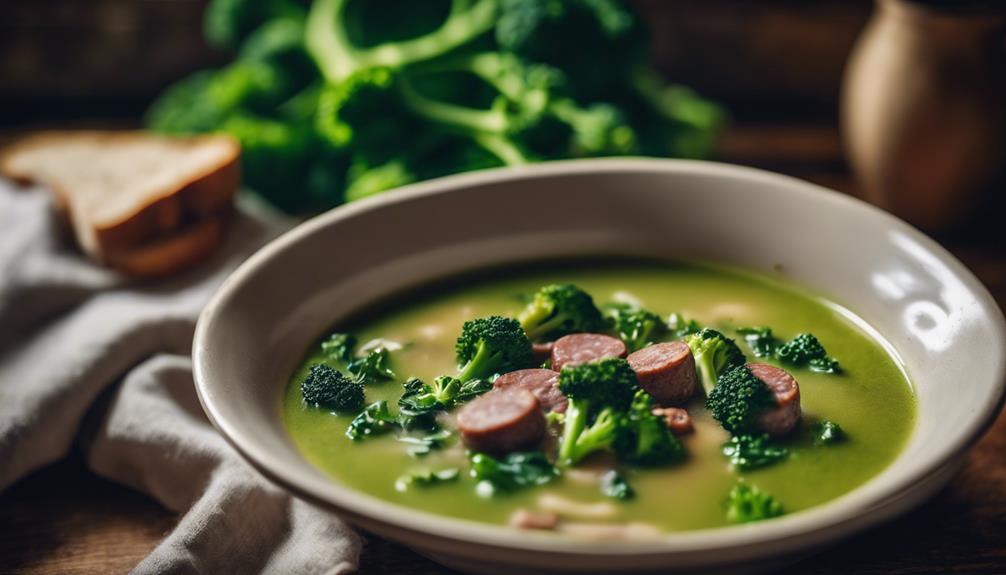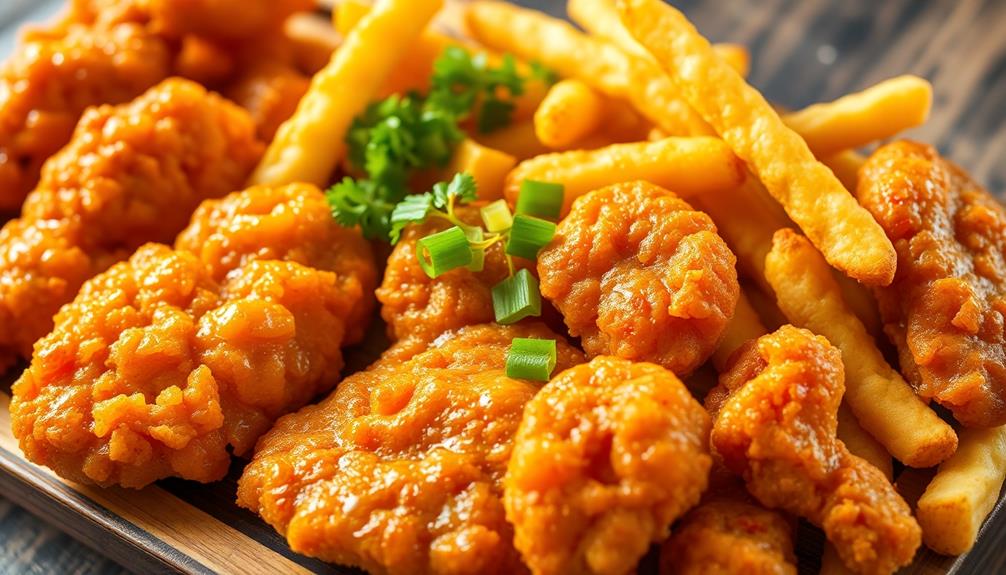Baking at high altitude can be tricky because lower air pressure affects how your ingredients behave. Gases expand faster, causing your cakes to rise quickly, which can lead to collapse. You'll also find that water boils at a lower temperature, making moisture evaporate quicker. To adapt, you might need to reduce sugar, increase liquid, or adjust your leavening agents. Monitoring baking times is essential since things can cook faster. If you're looking for tips on tackling specific recipes and techniques, there's plenty more you can discover to help conquer those high-altitude challenges.
Key Takeaways
- Lower air pressure at high altitudes causes baked goods to rise faster, risking collapse from excessive gas buildup.
- The boiling point of water decreases, leading to quicker moisture loss during baking.
- Adjustments such as reducing sugar and increasing liquid content are necessary to ensure proper texture and moisture retention.
- Baking times are generally shorter, requiring close monitoring to prevent over-baking.
- Higher oven temperatures are recommended to achieve proper setting of baked goods.
Effects of High Altitude
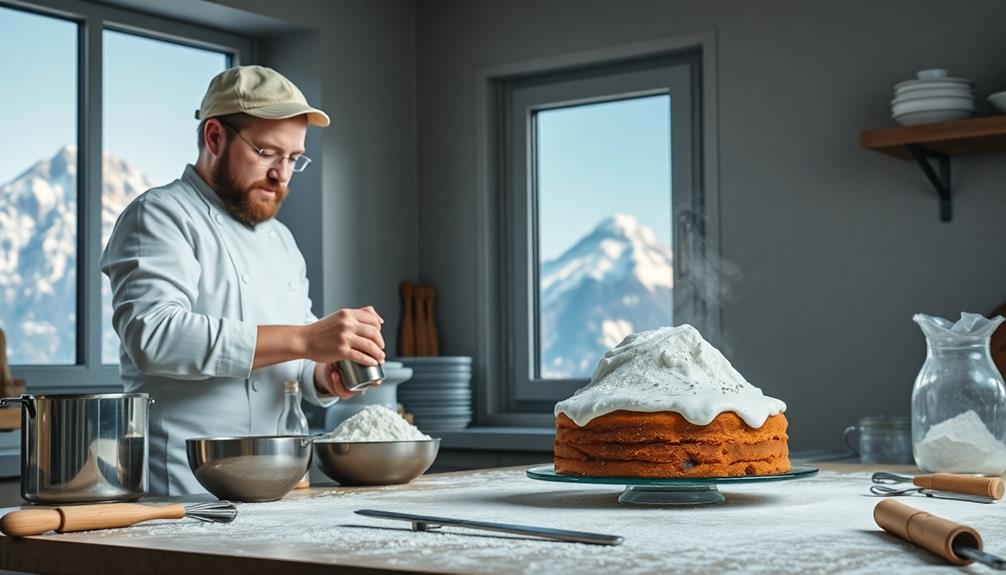
Baking at high altitude presents unique challenges that can turn a simple recipe into a complex science experiment. At high altitudes, the lower air pressure affects how baked goods rise. Your leavening agents will cause them to rise faster because gases expand more quickly in this environment. However, this rapid rise can lead to collapse if you're not careful, as excessive gas buildup can overwhelm your baked goods.
For instance, just as understanding seasonal ingredients in farm-to-table cooking helps in achieving flavor, grasping the nuances of high-altitude baking is crucial for success.
Additionally, the boiling point of water decreases, causing moisture loss to occur more rapidly. This means you'll need to adjust liquid quantities in your recipes to counteract the quick evaporation. Without enough liquid, your cakes and cookies may dry out, necessitating an increase in fat content as well.
You'll also notice that rising times and baking time are generally reduced at high altitudes. This requires you to keep a close eye on your creations to avoid overcooking.
Understanding these effects can help you navigate the intricacies of high-altitude baking and guarantee your treats turn out perfectly every time.
Recipe Adjustments

When tackling recipes at high altitude, you'll need to make some key adjustments to guarantee success. High-altitude baking presents unique challenges, such as changes in moisture and air pressure, so start by reducing sugar by 1-3 tablespoons per cup. This helps prevent excessive spreading and mottled surfaces.
Additionally, exploring culinary traditions from around the world can inspire new flavors and techniques for your baked goods. Next, increase the liquid content by 1-2 tablespoons per cup to counteract rapid evaporation and maintain moisture in your baked goods.
Adding an extra egg or egg white is essential, as it provides additional liquid and protein, enhancing the structural integrity of your creations. When it comes to leavening agents, decrease baking powder or soda by 1/8 to 1/2 teaspoon per teaspoon. This controls gas expansion and helps avoid collapsed cakes.
Lastly, don't forget to increase flour by 1-2 tablespoons per cup. This adjustment improves structural integrity and prevents dryness in the final product.
Baking Techniques
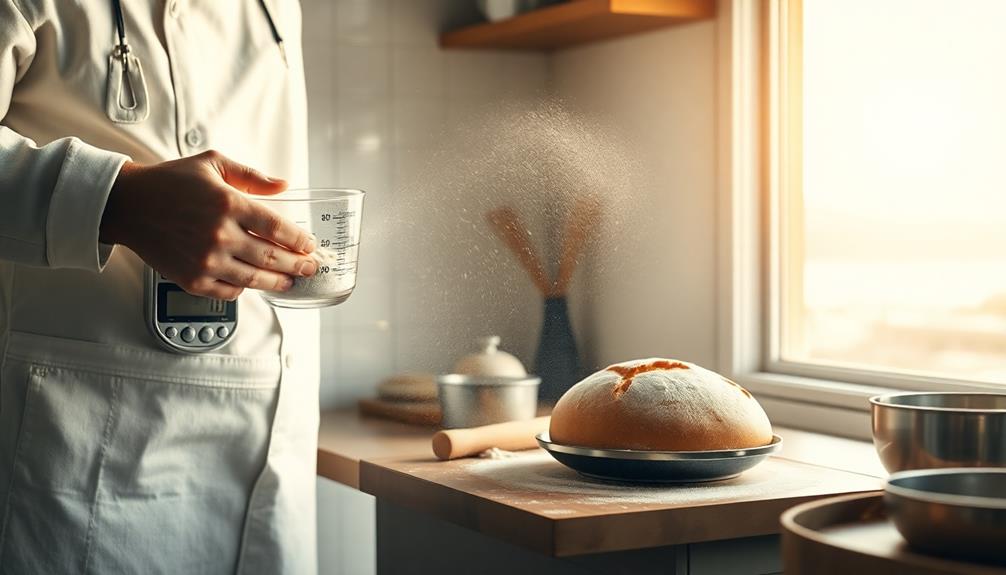
Adjusting your recipes is just the beginning; mastering the right baking techniques at high altitude can make all the difference. When you're at high altitudes, you'll want to increase your oven temperature by 15°F to 25°F. This guarantees your baked goods set properly before they over-expand due to lower pressure.
Just like how Red-Braised Pork Belly relies on precise cooking methods to achieve its rich flavor, baking at altitude requires careful adjustments for success.
Monitoring baking time is essential, too. Most items may require 5-8 minutes less per 30 minutes of baking time because they cook faster. For yeast recipes, reduce the yeast by about 25% and punch down the dough frequently. This helps prevent over-proofing and keeps your bread structure intact.
When baking cakes, consider adding an extra egg for improved moisture and stability. At high altitudes, you should also reduce sugar and leavening agents to avoid excessive rising and potential collapse.
Lastly, don't forget about your baking pans. Using parchment paper or greasing and flouring them can help prevent sticking, which is more common at higher elevations due to changes in batter viscosity.
Common Baking Issues
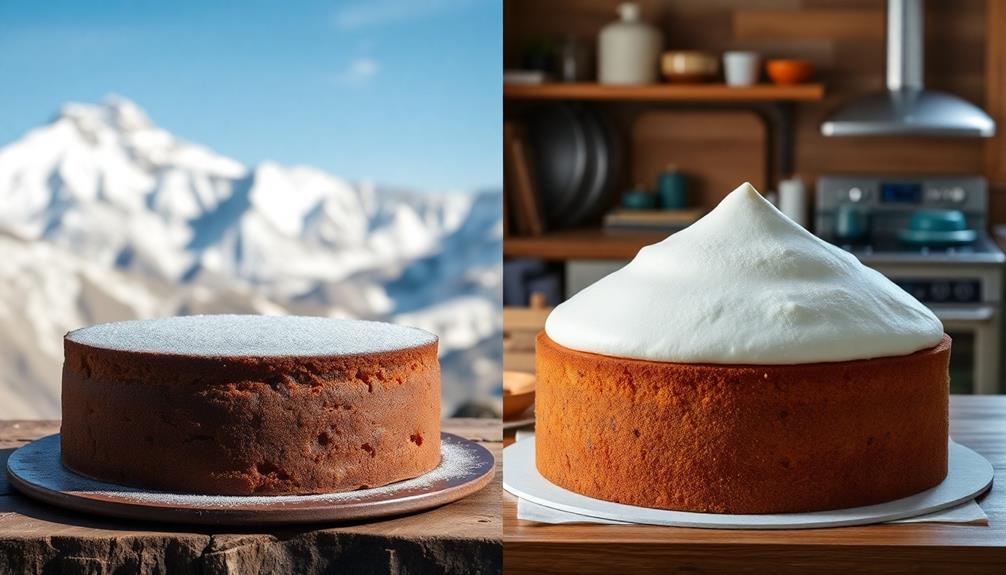
High-altitude baking often presents several challenges that can frustrate even the most seasoned bakers. You need to adjust your recipes to accommodate the effects of lower air pressure, which can greatly affect how baked goods behave.
| Baking Issue | Cause | Solution |
|---|---|---|
| Cakes | Rise too quickly, potential collapse | Lower baking powder, monitor rising time |
| Cookies | Excessive spreading | Adjust sugar and fat content |
| Yeast Breads | Over-expansion, collapse | Monitor dough to rise, adjust yeast levels |
| Fruit Pies | Longer baking times needed | Bake longer to cook filling |
| Dry and Crumbly Goods | Faster moisture evaporation | Add extra liquid to recipes |
For yeast breads, keep an eye on rising time; they can proof too quickly, leading to a collapse. Similarly, cookies often spread excessively due to a higher sugar concentration and the lower boiling point of liquids. Keeping these baking rules in mind will help you conquer the common issues that arise at high altitudes, ensuring your baked goods turn out deliciously.
Resources and Community Support

Finding the right resources and community support can make all the difference in mastering high-altitude baking. Organizations like the USDA Extension Service offer tailored guidance to help you tackle specific challenges faced at elevation.
Colorado State University's Cooperative Extension provides valuable tips and research-based recommendations that can greatly improve your baking success. Additionally, understanding the regional influences in cooking techniques can inspire your baking endeavors, as many traditional dishes showcase unique adaptations based on local ingredients and methods.
Cookbooks like "The Mountain Baker" and "Sugar High" focus exclusively on high-altitude baking techniques and recipes, giving you the insights you need to adjust your approach. These resources are essential for understanding how to modify ingredients and techniques in your recipes.
Engaging with local baking communities can also be incredibly beneficial. By connecting with fellow bakers, you can share your experiences, seek advice, and learn from their trial-and-error journeys.
Online forums and community groups are excellent places to ask questions and receive support from others who understand the high-altitude baking landscape.
Don't underestimate the power of community—tapping into these resources can elevate your baking skills and deepen your understanding of how altitude affects your creations. Embrace the support around you, and watch your baking flourish!
Frequently Asked Questions
How Do I Adjust Baking for High Altitude?
To adjust your baking for high altitude, reduce sugar, increase liquid, decrease baking powder, add an extra egg, and raise the oven temperature. These changes help guarantee your baked goods turn out perfectly.
At What Altitude Do You Need to Adjust Recipes?
At elevations above 3,000 feet, you need to adjust your recipes. By 5,000 feet, consider cutting baking powder or soda by 15-25% to manage the rapid gas expansion that occurs.
Why Are My Cookies Flat at High Altitude?
Your cookies are flat because the dough spreads too much. Reduce sugar and fat, add an extra egg, and increase the oven temperature. These adjustments help maintain shape and improve the overall texture. If you’re still having trouble with your cookie shape, try chilling the dough before baking. This will help the cookies hold their form while in the oven. For a fun twist, try incorporating candy corn into your favorite cookie recipe. One popular option is the candy corn cookies recipe, which adds a pop of color and sweetness to a classic treat.
How Does Low Altitude Affect Baking?
Baking at low altitude's a dream come true! You'll find your baked goods rise perfectly, with consistent textures and flavors. Plus, you won't need to tweak your recipes—just enjoy the delicious results every time!
Conclusion
In high-altitude baking, understanding how altitude affects your ingredients and techniques is essential for success. By adjusting your recipes and employing specific baking strategies, you can achieve delicious results. For instance, a baker in Denver, at 5,280 feet, learned to reduce sugar and increase flour in her favorite cake recipe, leading to a perfectly risen and moist treat. Embrace these adjustments, and you'll find that altitude doesn't have to mean sacrificing flavor or texture in your baked goods.


